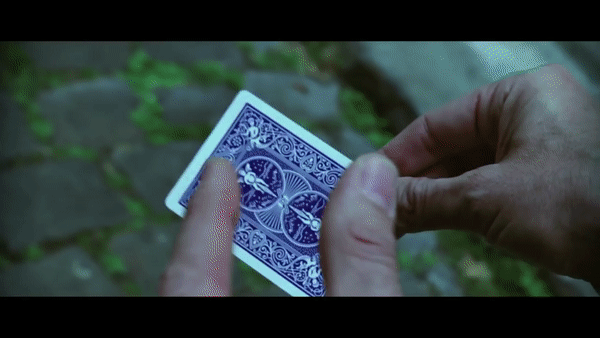Mailbag #102
/Dig the framework you talked about here when thinking of presentations for tricks.
I definitely have encountered the issue of trying to hang too "meaningful" or cerebral of a presentation to a visual or quick trick.
Made me think about some nuance to the framework and some exceptions as well - the first example that came to mind was your presentation for David Stone's Hologram effect [See Love Letters #5]. You hung a pretty cerebrally heavy presentation around that very visual trick. But the nuance I think is that the visual moment was just one component of a larger series of effects and moments that fit within the premise. It's like a really visual moment can be really strong as a climax punctuation that's set up by more cerebral moments leading up to it and around it. —JT
Yeah, when it comes to visual magic, the simpler it is, the more you can rely on the visual itself to carry the weight of the performance without much additional presentation. Money appearing, a cigarette disappearing, a candle changing color, a chewed piece of gum going back to its unchewed and wrapped state—these are all so fundamental in their nature that you can probably only screw them up by hanging a cerebral presentation on them.
Those tricks tell the story by themselves. At most, they require maybe a sentence to tell the tale:
“Damn, I wish I had a dollar for the vending machine.”
“I’ve only found one way to keep myself from smoking.”
“These candles don’t go with this decor at all.”
“Can you believe I’ve been chewing the same piece of gum for 14 years?”
David Stone’s Hologram involves a sticker appearing on the back of a card, and then that sticker changes color.
It’s two really solid visual effects, but they’re both kind of devoid of any meaning unless you come up with some sort of purpose for that moment. And that’s likely going to require a lot more than a single sentence.
Once you’ve gotten out of the single-sentence realm, you’ve already sacrificed the power of a clean visual piece of magic. At this point, a cerebral presentation may be required to save the visual moment from seeming arbitrary. You may need to come up with a presentation that suggests something other than, “Well, I guess he has a special card that can make it look like a sticker appears and changes color.” (Or whatever the case may be.)
I was watching Ben Earl's "Brilliant Basics" and in the tips for card forcing section of the tutorial he mentioned an interesting piece of psychology. He mentioned when forcing a card on someone: saying that "it's OK if I see the card because it's not that type of trick" is a disarming ploy. Laymen might not know why else you'd need to "make them '' pick a card if the plot of the trick is not immediately obvious.
I wanted to ask you what you thought about it/if you agree, and when you do the reverse psychology force for crazy reveals etc, do you look at the card or look away when forcing? —AFC
That’s interesting. Off the top of my head, I’m not 100% sure how that would be perceived, because I don’t know what spectators think when you say, “it’s not that kind of trick.” But I can sort of see where he’s coming from.
I will occasionally do something similar.
I used to force a card and then say something like, “And what did you get?” My theory being that me asking to see what they got only made sense if I didn’t know what they’d chosen. So, on some level, this was reinforcing the idea that the card was a free choice.
The issue with that is that sometimes, after the climax of the trick, a spectator would say something like, “Yeah, but you saw what I picked.”
Now, that shouldn’t make a difference if I have 100 tealight candles in the shape of the card they chose in the other room…
But still, you know if you actually perform for regular people, they will sometimes pounce on what they think is a weakness, even if it doesn’t really explain what they saw.
I think part of their thinking is, “Well, since he saw the card I picked, he knew if the right card was revealed in the other room.” And they see me knowing the card as me having the option to not complete the trick or to switch gears and do something else.
So what I might have been gaining psychologically with some people by asking to see the card, I was losing with other people who saw that as me now having more information than I should.
These days, if I want to use a line like that, I say something like, “And can I see what you got? Actually… no. Don’t show it to me yet. I want to be surprised.”
That way, I still get to plant the seed that I don’t know what the card is. But by stopping them from actually showing it to me, they can’t think back later and say, “Oh, but he knew the card,” and see that as some sort of flaw or weakness in the trick.
Coincidentally, I received two emails this week talking about the WikiTest app and both asked what I would do if the spectator noticed the word they thought of is not in the article. (Those who have Wikitest will know what I’m talking about).
I haven’t done WikiTest regularly for at least a couple of years now, and I never remember having that issue when I did. But, I think this could be a way to go if you’re concerned about it…
You have your friend look up their subject. Then you tell them to look at you and scroll down a little bit towards a random spot in the middle of the page. (You’re having them look at you so they’re not paying close attention to the layout of the page. But your rationalization to them is that you don’t want them reading too much and getting a lot of jumbled thoughts.)
Tell them to look at the phone and pick the first big word that jumps out at them, and then put the phone away.
You go on to reveal the subject they searched. Then it’s time to discern the word they’re “only thinking of.” Start with the first letter.
“It starts with an… N, I believe. Yes?”
“No.”
“Hmm… what did it start with?”
“An R.”
Look confused. “Okay… uhm… focus on the word again.”
Concentrate.
“Okay, I think I may have rushed you earlier. I’m sensing a disconnect of sorts. You might have misread a word. So I’m not sure if you’re actually thinking of a word from the article. But that’s okay, it doesn’t really matter. Just focus on whatever word you thought you saw.” You then reveal to them the word they’re thinking of.
If they go back and look at the article and they don’t see their word… well now it’s an even stronger trick. You didn’t read their mind of something they read. You read it of something they misread. A word that didn’t exist on the page. It only existed in their mind.
The weakness becomes the strength.
By having them scan to a random point on the page without looking, and then rushing them a little when they think of the word on the page, it’s unlikely they’ll notice the page is different later on. And by delaying that revelation until after the first one, there is even more time for them to forget any other details besides the word they saw. And, in fact, the idea that maybe they misread something or misremembered it won’t seem too far-fetched at that point. On top of that, having to ask for the first letter is almost justified because of this “disconnect” of the way their brain processed what they “actually” saw.













